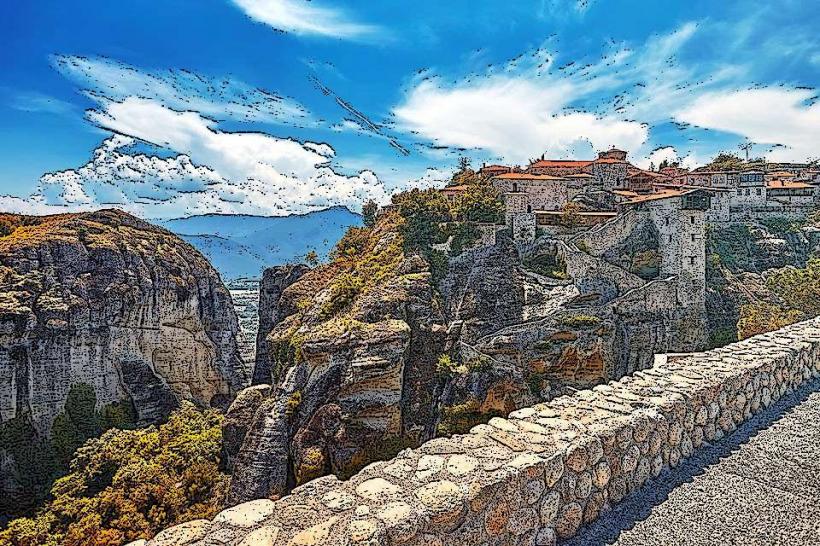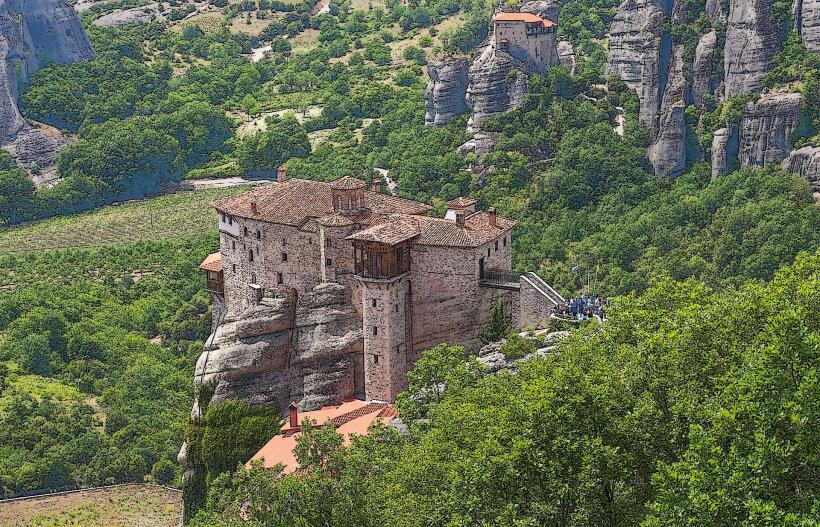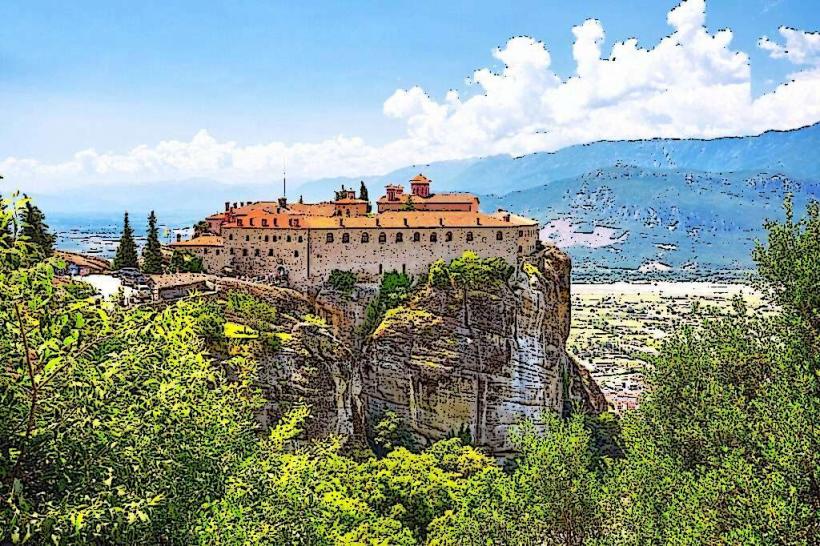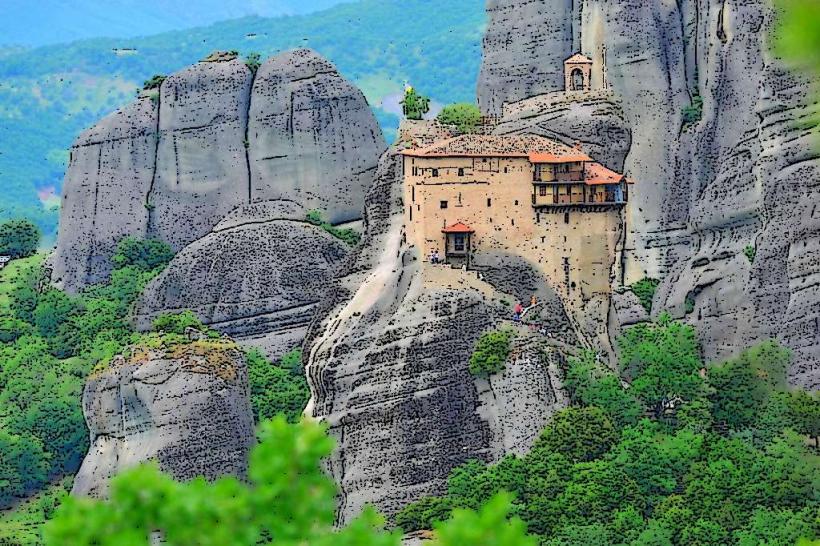Information
Landmark: Varlaam MonasteryCity: Meteora
Country: Greece
Continent: Europe
Varlaam Monastery is one of the most prominent and well-visited monasteries in the Meteora region of central Greece. Like the other monasteries of Meteora, it is perched atop one of the towering rock formations, offering stunning views of the surrounding area. The monastery, founded in the 14th century, is named after its first monk and ascetic, Varlaam, who is credited with establishing a monastic presence at the site.
1. Historical Background
- Founding: Varlaam Monastery was founded in the 14th century, around 1350. The first monk, Varlaam, is said to have arrived at the site as a hermit, seeking a secluded place for prayer and ascetic life. The monastery eventually grew in influence, with additional monks joining Varlaam, and it became one of the most important monastic centers in Meteora.
- Development: Like other Meteora monasteries, Varlaam grew in importance over the centuries. Initially, the monastery was modest in scale, but it expanded and became a significant center for religious life, education, and cultural preservation. The monastery's heyday occurred during the 16th century, when it attracted many monks and pilgrims.
- Decline: As with many of the Meteora monasteries, Varlaam began to decline during the 18th century due to a combination of factors such as economic difficulties, the Turkish occupation, and the decrease in the number of monks. It wasn't until the 20th century that efforts were made to restore and revive the monastery.
2. Architecture and Layout
Varlaam Monastery is a stunning example of Byzantine monastic architecture, blending traditional religious design with the natural landscape of the Meteora rocks. The architecture of the monastery is typical of the monastic structures in Meteora, but it stands out due to its scale, frescoes, and impressive construction techniques.
Location and Accessibility: Like other Meteora monasteries, Varlaam is located at a significant height, approximately 373 meters (1,224 feet) above sea level, perched on one of the rock spires. Originally, access to the monastery was extremely difficult and dangerous, with monks using ladders, ropes, and baskets to reach the top. Today, however, visitors can reach the monastery via a road and a set of stairs leading up the rock, making it more accessible to tourists.
Monastery Complex: The monastery complex is made up of several buildings that are clustered together on the narrow rock ledge. Some of the key features of the complex include:
- Church of the Transfiguration: The main church (or katholikon) is dedicated to the Transfiguration of Christ and is one of the architectural highlights of the monastery. The church is designed in the Byzantine style, with a central dome and richly decorated interiors. The frescoes, many of which were painted by Theodoros and Spyridon, two important iconographers of the 16th century, depict biblical scenes and saints, making it a significant work of religious art.
- Cells and Rooms: The monastery also contains monks' cells, a refectory (dining room), and rooms for religious study and prayer. These spaces are simple yet functional, designed for the monks’ ascetic way of life. The buildings are connected by narrow walkways and staircases, adding to the monastery's fortress-like appearance.
- Cemetery: Like other monasteries in Meteora, Varlaam has a cemetery for the burial of its monks. The cemetery is located within the monastery's walls and is a place for contemplation and remembrance.
- Iconostasis: The iconostasis (the decorated screen separating the altar from the main worship space) is a notable feature of the church. It is adorned with richly painted icons that depict scenes from the Bible and the lives of saints, reflecting the religious devotion of the monastery's monks.
3. Frescoes and Artistic Treasures
Varlaam Monastery is home to a remarkable collection of frescoes and icons, many of which are considered masterpieces of post-Byzantine religious art. The frescoes are particularly famous for their vivid colors, intricate details, and theological significance.
- Frescoes in the Katholikon: The walls and ceilings of the church are covered in frescoes that depict scenes from the Life of Christ, the Last Judgment, and various saints. The frescoes were created by Theodoros and Spyridon, two renowned painters from the 16th century. Their work is highly regarded for its artistic quality and its deep spiritual message.
- Iconostasis: The iconostasis, another focal point of the church, is richly adorned with icons painted in vibrant colors. These icons were painted by famous iconographers and are of great religious significance. The iconostasis serves to separate the altar from the rest of the church, symbolizing the division between the divine and the earthly realms.
The monastery's collection of manuscripts and liturgical items, including ancient books, are also displayed in the monastery's small museum. These artifacts offer insight into the spiritual and intellectual life of the monastery.
4. Role in Religious Life
- Monastic Life: Like other monasteries in Meteora, Varlaam was established as a place for monastic life, where monks could live a life of prayer, asceticism, and reflection. The monks of Varlaam were dedicated to the Greek Orthodox faith, and the monastery played an important role in maintaining religious traditions and practices, especially during difficult periods such as the Ottoman occupation of Greece.
- Pilgrimage Site: Varlaam, along with the other monasteries of Meteora, became an important pilgrimage site for Christians, both in Greece and abroad. Pilgrims traveled to the monastery to seek spiritual guidance, take part in religious services, and experience the tranquility of the monastic life.
- Resistance and Preservation: During times of political and religious upheaval, such as the Ottoman occupation, the monasteries of Meteora, including Varlaam, were often centers of resistance. The monasteries played a role in preserving Greek culture and Orthodox Christianity in the face of foreign domination.
5. Decline and Restoration
- Decline: Over time, the number of monks at Varlaam, like other monasteries in Meteora, began to decrease. During the 18th and 19th centuries, the monasteries of Meteora faced difficulties, including economic challenges, invasions, and the shifting political landscape. By the 19th century, Varlaam had largely fallen into decline.
- Restoration: In the 20th century, efforts were made to restore and revive Varlaam Monastery. Like other monasteries in Meteora, Varlaam was renovated, its frescoes were conserved, and its buildings were restored. Today, Varlaam is an active monastery, although the number of monks is much smaller than in the past. It is open to visitors and continues to serve as a place of worship and spiritual retreat.
6. Visitor Experience
Accessibility: Visitors can reach Varlaam Monastery via a paved road and a series of stairs that lead up the rock to the monastery's entrance. The climb is not as difficult as it once was, thanks to modern infrastructure. Visitors can take in the breathtaking views of the surrounding Meteora rock formations and the Thessalian Plain below.
Tourist Attractions: The main attractions at Varlaam include the Katholikon with its stunning frescoes, the iconostasis, the monastery museum, and the scenic views from the monastery’s grounds. The peaceful atmosphere and remarkable beauty of the monastery make it a memorable experience for visitors.
Cultural Significance: Varlaam Monastery, like the other monasteries of Meteora, is an important part of Greek cultural and religious heritage. Visitors not only admire the monastery’s architecture and art but also experience its historical significance and the ongoing religious life that continues to this day.
7. UNESCO World Heritage Site
Varlaam Monastery is part of the Meteora UNESCO World Heritage site, which was designated due to the unique combination of natural beauty and cultural significance. Meteora’s rock formations are among the most remarkable in the world, and the monasteries, including Varlaam, stand as testaments to human ingenuity and spiritual devotion.
Conclusion
The Varlaam Monastery is one of the most fascinating and accessible monasteries in the Meteora region. Its breathtaking location, stunning architecture, rich history, and incredible frescoes make it a must-see destination for anyone visiting central Greece. As an active monastery, it continues to serve as a spiritual center while also attracting visitors from around the world to experience its beauty and historical significance.






